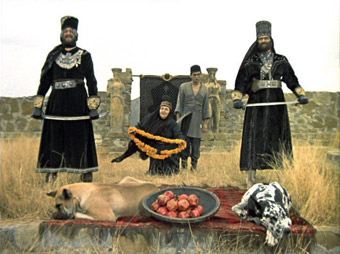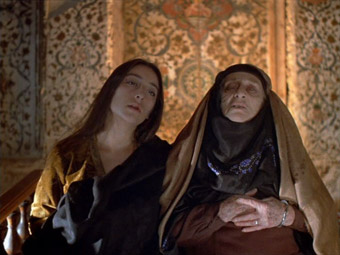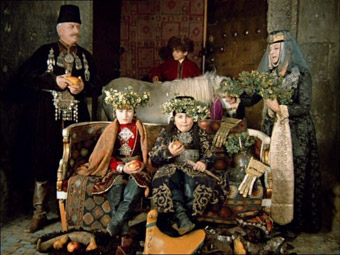|
When a DVD arrives on my doormat for review, I always dream that I'll have time to approach it in a manner that my lifestyle rarely allows. If it's a film I haven't seen by a director whose work I am in the process of discovering, then I ideally want to hunt out as many of his or her other works as possible so that I might be able to properly judge the film, not just on its own merits, but also in relation to the filmmaker's oeuvre. But even if you review films for a living and have free access to a range of materials, you still have deadlines to meet. If, like us lot here, you're trying to fit the whole process in a few gaps in your working week and disorganised home life, then good bloody luck. As a result, you intermittently commit yourself to a review that with the benefit of hindsight seems incomplete, as subsequent viewing experience prompts you to smack yourself in the forehead and say "Oh, if only I'd seen that film first."
Such is the case with Ashik Kerib, the rather wonderful final film of Russian experimental filmmaker Sergei Parajanov. Having seen only one of the director's works a good few years earlier, I was effectively going in blind. Completely entranced by the film's structure and style, I assumed that its approach to storytelling was shaped by the folk-tale influenced story on which it was based. In retrospect, maybe I should have noted that this style is unique less to that film than its director, and that his approach to narrative just happened to be perfectly suited to the story at that film's centre. Much of what defines Ashik Kerib as special, you see, is also present in spades in Parajanov's previous film, The Legend of the Surami Fortress [Ambavi Suramis tsikhitsa], and is clearly a major aspect of what defines his approach to filmmaking. In terms of the director's career it's a crucial work, his return to filmmaking after a sixteen year break following two prison terms for trumped-up charges drawn up by a ruling authority as punishment for his rebellious nature.

Based on a 19th century novella by Daniel Chonqadze and a nationalist Georgian folk song, The Legend of the Surami Fortress does not follow the Hero's Journey structure anything like as comfortably as its cinematic successor. It certainly starts in Joseph Campbell fashion, with a hero embarking in a quest that will result in the freeing of his princess, but from then on things really don't go to plan or conform to western folk story expectations.
The would-be hero in question is Durmishkhan, who has been released from prison by a feudal prince, whose seemingly secure domain has but one weak spot, the Surami Fortress, whose walls continue to crumble in spite of repeated attempts to repair them. Durmishkhan's first act of freedom is to plead with his lover Vardo, the story's likely princess, to dance for the prince's guests, something she has no interest in doing. Aware that this is not the sort of request to refuse if you want to keep your head, Durmishkhan persuades Vardo to do the prince's bidding. Fearing Vardo will, like her predecessors, be indefinitely held captive by the lord, Durmishkhan then heads off to seek his fortune in order to buy her freedom, despite her conviction that he will never return.
While the set-up is similar to that in Ashik Kerib, storytelling tradition soon takes a few knocks. For a start, Vardo's ability to accurately predict the gender of the princess's unborn child impresses the prince enough to secure her freedom without her lover's assistance. Durmishkhan, meanwhile, has been given a fine horse to carry him on his quest but doesn't get far before a royal emissary catches him up, tells him that the gift was not meant to be taken seriously and was just the prince showing off to his guests, and takes the horse back to camp, leaving the despairing fortune-seeker to continue on foot. Fortunately for him he is befriended by travelling trader Osman-Aga, who effectively introduces him to a new life in which Vardo is soon only a distant memory. Vardo, meanwhile, continues to wait in vain for her lover's return, but a trip to a famed fortune teller changes her life and ultimately seals Durmishkhan's fate.
The stylistic similarities to Ashik Kerib are strong enough for the two to qualify almost as companion pieces, with the story again told as a series captioned chapters consisting of exquisitely composed moving tableaux and still-life arrangements of story-relevant objects. As with its cinematic successor, there is considerable minimalist appeal in this approach, with key events covered wide almost as stand-alone theatrical pieces and the narrative elements on occasion almost overwhelmed by the action that surrounds them. At times this does create the sense that the component parts are being given prominence over the narrative whole – the arrangement of action in some of the wide shots is even busier than in Ashik Kerib – and is different enough to the storytelling norm to require viewer concentration to keep up with what's going on. It also means that some of the socio-political subtext is subtle enough to make you wonder how much was intended and how much you've managed to read into meaningful seeming images and dialogue.

Does it matter? Not a bit. As with Ashik Kerib, the real magic of the story lies in the manner of its telling, in the care that has gone into the compositions and their sometimes striking juxtaposition, in the melding of the arts of painting, illustration, photography, theatre and cinema into single brief but captivating sequences. This may sound a little superficial, a case of style over content given credibility by Parajanov's status and the film's non-Hollywood origins, but it's an approach that allows the filmmakers to aesthetically and thematically layer almost every shot in the film, in the process transforming a simple story into a visually, aurally and narratively rich experience.
As with Ashik Kerib, this is a restoration carried out by the Russian Film Council, who have again done a decent job, though small imperfections remain. Framed 1.33:1, the picture is detailed and boasts a very good contrast range, but the colour timing of the source print is uneven, resulting in some occasional shifts in the colour balance, sometimes mid-sequence. Film grain is often evident but I'm guessing that's true to the original print. There is some intermittent flickering, which, though far from distracting, suggests the remastering process only went so far. A generally good transfer that's only a few hairs short of the quality of the one on the Ashik Kerib disc.
The Dolby 2.0 soundtrack is a little restricted in its dynamic range but is otherwise clear and free of audible blemishes. The music used is narrower in variety than that in Ashik Kerib, but is distortion-free.
Sergey Paradzhanov (26:36 – the spelling is as on the menu)
A featurette constructed largely from three interviews with Paradzhanov's wife Svetlana Shcherbatyuk, who details how the couple met (he was 30, she was 16), how difficult Sergei was to live with, the events leading up to his arrest and the absurdity of the charges that landed him in jail. Included are snippets of documentary material that owners of the Ashik Kerib disc will recognise, brief home movie footage, archive photographs, extracts from letters sent by the imprisoned Sergei to his wife, and examples of his artwork, much of which was created during his prison term. Touchingly, Svetlana states that "after his death, we all became orphans" and suggests that his mission on earth was to turn everyday life into a celebration. A most worthwhile and interesting extra.

Veriko Andzhaparidze (9:21)
A short, Russian-made and reverential portrait of the woman who has been called the Queen of Soviet Theatre and who plays the old fortune teller in Surami Fortress. The film itself is a few years old now and not in great shape, but is still of real interest and includes a brief interview with Andzhaparidze's daughter Sofiko Chiaureli, a successful actor in her own right and who played Vardo in this film.
The architecture of ancient Georgia (6:20)
An old monochrome information film of the sort you'd expect to see before the main feature in cinemas in years past, focussing on the Georgian architecture and artifacts in the town of Telavi.
There's also a Photo Album consisting of 8 high quality production stills, which are actually part of a 37-page extra that includes Filmographies of cast and crew members and links to relevant film credits.
A short while ago a friend of mine was visiting, just as I was checking something on this very DVD, and was stopped in her tracks by what she saw. After asking what it was she expressed her amazement at the images that were unfolding. "I've never seen a film like this before," she remarked, "It's like art. Beautiful!" She immediately wanted to see more, and this is the strength of Parajanov and co-director Dodo Abashidze's approach – what could so easily have played as superficial surface dressing pulls you most effectively into the story and makes even the familiar seem fresh and daring. The disc has its small imperfections, but is still a worthy purchase for fans of the director's work and/or those who favour the bold over the conventional.
|